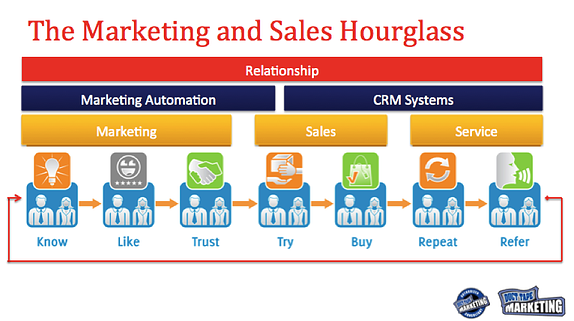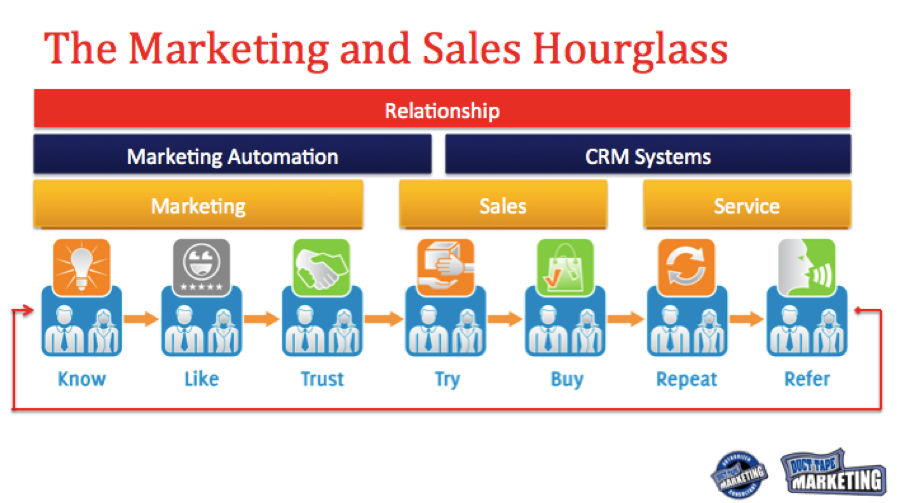Sales Automation vs Marketing Automation
I was recently talking with a prospective client about automation for the business development process, specifically marketing automation, and she asked me to explain the difference between sales automation and marketing automation.
It was a great question – one that I had never gotten before in that phraseology. The question itself points to the ongoing blending of the sales and marketing processes. The blend is what my friends at HubSpot refer to as smarketing and which was the impetus (I think) behind John Jantsch’s new book Duct Tape Selling.
We have traditionally thought about sales automation as the CRM application (customer relationship management). CRM is the tool that salespeople use to track, manage, and forecast their opportunities; that marketing sometimes uses to see results; and that customer service uses to track engagement.
Marketing automation, a relatively new term, usually refers to an email marketing and scoring system or a more robust system that also captures web visitors, social engagement, and other relevant analytics (HubSpot is our tool of choice for this).
I believe that in this new mobile- and search-driven world, you need marketing automation to deal with the entire customer buying journey, and sales automation is a smaller part of that.
The image below shows, in general, where sales and marketing automation fall in the buyer’s journey:

However, we also think it's helpful to consider both complexity of buying your product or service and the volume of transactions your business must do to be profitable.
Low Complexity, Low Volume of Transactions
CRM systems allow your sales team to store and track critical prospective customer information. But not every business needs that level of sales automation. If you have a short or non-complex sales cycle and don’t have a very high sales volume, the effort of tracking every opportunity is more work that it may be worth. If you sell in a retail environment (physical or online) or you run a trade or craft business, CRM may not be the right thing to be considering – a loyalty application is probably a better consideration. (Along with some basic nurture-marketing tools like email marketing.)
Low Complexity, High Volume of Transactions
Marketing automation is critical for the non-complex sale, where the speed and volume of transactions are the core of the business. In this environment, you generally don’t find a highly trained sales force; its a marketing automation tool (like HubSpot) that helps you identify, qualify, and nurture a prospect until they're ready to execute a transaction at a low cost per customer acquisition. You may also want a loyalty application/program to help with repeat business.
High Complexity, Low Volume of Transactions
In this type of environment, you want to have a CRM system. There are multiple stages and meetings to a new client acquisition, and you want to be managing the information around each. You probably have a trained (and expensive) sales team that needs tools to run their opportunities. And depending on the typical close rate (number of prospects to acquire a customer) and sales cycle your business experiences, you may also want to add marketing automation that helps with attracting inbound lead traffic – because even though you do a low volume of transactions, you still need a high volume of prospects to support a complex, long sales cycle (and your salespeople may not be the best lead-generators).
High Complexity, High Volume of Transactions
In this environment, you need marketing automation to attract and nurture a high volume of prospects through the initial buying process. And then you need to have a CRM system for your sales team to manage the pipeline of prospects who are closer to the purchase decision point.
Ultimately, your current customer buying process, approach to growing your business, and goals will dictate the systems needed. As you consider what to buy/use/license/try, remember that each of these systems were initially designed for a specific function. Many have grown (bloated) over the years to do more and more functions across larger market segments, so as you evaluate products, look at what they do best and how that aligns with your needs. There's no product today that does everything well, so if you need both sales and marketing automation, you will have to accept trade offs in a single system or integrate multiple systems together.


Submit Your Comment